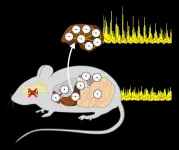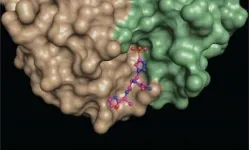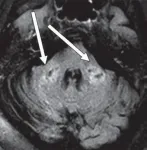New data on COVID-19 patients with diabetes show that one in five die within
28 days of hospital admission
2021-02-18
(Press-News.org) Updated results from the CORONADO study, analysing the outcomes of patients with diabetes admitted to hospital with COVID-19, shows that one in five patients die within 28 days while around half are discharged. The study is published in Diabetologia (the journal of the European Association for the Study of Diabetes [EASD]), and is by Professor Bertrand Cariou and Professor Samy Hadjadj, diabetologists at l'institut du thorax, University Hospital Nantes, INSERM, CNRS, and University of Nantes, France, and colleagues.
In May 2020, preliminary results from CORONADO (Coronavirus SARS-CoV-2 and Diabetes Outcomes), with a smaller sample size, showed that 10% of patients with diabetes and COVID-19 died within 7 days of hospital admission.
This updated analysis included 2796 participants from 68 centres across France: almost two thirds (64%) were men, mean age 70 years, with median body mass index of 28 kg/m² (falling into the overweight range). Microvascular and macrovascular diabetic complications were found in 44% and 39% of participants, respectively.
Within 28 days, 1404 (50%) of the patients were discharged from hospital with a median duration of hospital stay of 9 days, while 577 participants died (21%). Of the remaining patients, 12% remained hospitalised at day 28, while 17% had been transferred to facilities different from their initial hospital.
Computer modelling revealed various factors such as younger age, routine diabetes therapy with the drug metformin, and longer symptom duration on admission were associated with a higher chance of discharge from hospital.
History of microvascular complications, routine anticoagulant therapy (to prevent blood clots), shortness of breath on admission, abnormal levels of liver enzymes, higher white blood cell counts and higher levels of the systemic inflammatory marker C-reactive protein were all associated with a lower chance of discharge and a higher risk of death. Patients whose diabetes was regularly treated with insulin (possibly indicating a more advanced state of diabetes) were at a 44% increased risk of death compared with those not treated with insulin.
An unusual finding from this study was a 42% increased risk of death for patients with diabetes receiving statin treatment for high cholesterol - however, the authors make clear since this is an observational study, it is difficult to make definite conclusions about any relationship with statins, or any other treatment.
The study also found that long term blood sugar control assessed with pre-admission or admission glycated haemoglobin (HbA1c) did not impact on the fate of COVID-19 patients, with no significant association with death or with discharge within 28 days. In contrast, an increased level of plasma glucose on admission was a strong predictor of death and, consistently, of a lower chance of discharge.
The authors conclude: "The identification of favourable variables associated with hospital discharge and unfavourable variables associated with death can lead to patient reclassification and help to use resources adequately according to individual patient profile."
INFORMATION:
ELSE PRESS RELEASES FROM THIS DATE:
2021-02-18
The tuberculosis (TB) vaccine Bacillus Calmette-Guerin (BCG) could protect newborns against a variety of common infections, such as upper respiratory tract infections, chest infections and diarrhoea, according to a new study in The Lancet Infectious Diseases.
The research is the first of its kind to rigorously investigate the full range of illnesses BCG could protect infants against. It suggests that vaccinating all babies on the day of birth with BCG could reduce neonatal infections and death in areas with high infectious disease rates, potentially saving thousands of lives a year. The results also increase the possibility that the vaccine might be used to protect children and adults against ...
2021-02-18
Circadian clocks, which regulate the metabolic functions of all living beings over a period of about 24 hours, are one of the most fundamental biological mechanisms. In humans, their disruption is the cause of many metabolic diseases such as diabetes or serious liver diseases. Although scientists have been studying this mechanism for many years, little is known about how it works. Thanks to an observation tool based on bioluminescence, a research team from the University of Geneva (UNIGE) were able to demonstrate that cells that compose a particular organ can be in-phase, even in the absence of the central brain clock or of ...
2021-02-18
LA JOLLA--(February 17, 2021) In structural biology, some molecules are so unusual they can only be captured with a unique set of tools. That's precisely how a multi-institutional research team led by Salk scientists defined how antibodies can recognize a compound called phosphohistidine--a highly unstable molecule that has been found to play a central role in some forms of cancer, such as liver and breast cancer and neuroblastoma.
These insights not only set up the researchers for more advanced studies on phosphohistidine and its potential role in cancer, but will also enable scientists ...
2021-02-17
Deprive a mountain range of its wolves, and soon the burgeoning deer population will strip its slopes bare. "I now suspect that just as a deer herd lives in mortal fear of its wolves, so does a mountain live in mortal fear of its deer," wrote ecologist Aldo Leopold in his landmark 1949 title "A Sand County Almanac."
Leopold proposed that predators keep herbivore populations in check to the benefit of an ecosystem's plant life. Remove one link in the food chain, and the effects cascade down its length. The idea of a trophic cascade has since become a mainstay in conservation ecology, with sea urchins as a prime example just off the California ...
2021-02-17
Rapid global urbanization has dramatically changed the face of our planet, polluting our atmosphere with greenhouse gases and causing global warming. It is the need of the hour to control our activities and find more sustainable alternatives to preserve what remains of our planet for the generations to come.
Carbon dioxide (CO2) and carbon monoxide (CO) make up a large proportion of industrial flue gases. Recent research has shown that certain microorganisms are capable of metabolizing these gases into useful by-products. Thus, attempts are now being directed to ...
2021-02-17
BOSTON - Delirium, a common syndrome among older adults, particularly in those who have recently undergone surgery, critically ill patients in the ICU, and in older patients with multiple health issues, is a form of acute confusion that is characterized by poor attention, disorientation, impaired memory, delusions, and abrupt changes in mood and behavior. Moreover, patients who experience delirium are at increased risk of long term cognitive decline. Recently, clinicians and scientists have recognized that delirium is one of the first signs of COVID-19 infection in older patients and that it occurs frequently in patients with severe COVID-19 disease.
In a new study led by an interdisciplinary team of gerontologists, geriatricians, precision medicine ...
2021-02-17
Dogs are generally considered the first domesticated animal, while its ancestor is generally considered to be the wolf, but where the Australian dingo fits into this framework is still debated, according to a retired Penn State anthropologist.
"Indigenous Australians understood that there was something different about the dingoes and the colonial dogs," said Pat Shipman, retired adjunct professor of anthropology, Penn State. "They really are, I think, different animals. They react differently to humans. A lot of genetic and behavioral work has been done with wolves, dogs and dingoes. Dingoes come out somewhere ...
2021-02-17
Scientists from the Skoltech Center for Computational and Data-Intensive Science and Engineering (CDISE) and the Skoltech Digital Agriculture Laboratory and their collaborators from the German Aerospace Center (DLR) have developed an artificial intelligence (AI) system that enables processing images from autonomous greenhouses, monitoring plant growth and automating the cultivation process. Their research was published in the journal IEEE Sensors.
Modern technology has long become a fixture in all spheres of human life on Earth. Reaching out to other planets is a new challenge for humankind. Since greenhouses are likely to be the only source ...
2021-02-17
BOSTON - Use of a cosmetic laser invented at Massachusetts General Hospital (MGH) may improve the effectiveness of certain anti-tumor therapies and extend their use to more diverse forms of cancer. The strategy was tested and validated in mice, as described in a study published in Science Translational Medicine.
Immune checkpoint inhibitors are important medications that boost the immune system's response against various cancers, but only certain patients seem to benefit from the drugs. The cancer cells of these patients often have multiple mutations that can be recognized as foreign by the immune system, thereby inducing an inflammatory response.
In an attempt to expand the benefits of immune checkpoint inhibitors ...
2021-02-17
Leesburg, VA, February 17, 2021--According to an open-access article in ARRS' American Journal of Roentgenology (AJR), COVID-19-related disseminated leukoencephalopathy (CRDL) represents an important--albeit uncommon--differential consideration in patients with neurologic manifestations of coronavirus disease (COVID-19).
"Increasingly," wrote Colbey W. Freeman and colleagues from the University of Pennsylvania, "effects of COVID-19 on the brain are being reported, including acute necrotizing encephalopathy, infarcts, microhemorrhage, acute disseminated encephalomyelitis, and leukoencephalopathy."
Among the 2,820 patients with COVID-19 admitted to the authors' institution between ...
LAST 30 PRESS RELEASES:
[Press-News.org] New data on COVID-19 patients with diabetes show that one in five die within
28 days of hospital admission





